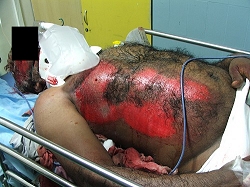
A 58yr old political leader arrived in the ED with a history of being involved in
a road traffic accident. He was a rear seat passenger in a car which was hit by a
speeding truck from the side. He arrived approximately 45 mins after the accident.

On arrival to the ED, his vitals were P-160, BP-Not recordable, RR-60
Therefore he was triaged as Priority 1
Two EM residents along with a team of nurses attended to him. They followed the ATLS
guidelines of trauma resuscitation. The following problems were picked up during
the primary survey.
Partial airway obstruction with active oral bleeding
Right hemothorax
Class IV shock
GCS 7/15
Open fracture of right femur
He was intubated along with spinal immobilisation. A chest tube was inserted.
3 litres of normal saline was infused along with 3 units of blood. The bleeding
was controlled and the fracture site stabilised.
Vitals at the end of 20mins of resuscitation were P-110, BP-100/70, RR-Ventilated
The secondary survey along with the trauma series of xrays revealed more injuries:
Fracture Rt maxilla (Le Fort III)
Fracture Rt zygoma with Rt subconjunctival hemorrhage
Multiple teeth loss
Fracture C4, undisplaced
Fracture Rt clavicle
Fracture Rt humerus, head
Fracture Rt 3,4,5,6,7,8,9 ribs with hemothorax
Fracture Rt iliac bone
swelling in the wrist
A FAST scan was positive for free fluid in the abdomen.
Surgery, orthopedics, neurosurgery, cardiothoracic and anesthesia were now called in.
More xrays showed
Fracture Rt femur, communited
Fracture Rt radius distal end
CT brain was normal
He was taken to the OT, bleeding from a 6cm hepatic laceration was controlled.
Fractures were fixed. He remained in intensive care for 11 days.
He made good recovery and was discharged following two more operations.
This particular case is discussed to highlight the role of ATLS which stands for
Advanced Trauma Life Support.
The following section is taken from Wikipedia-The Free Encyclopedia
http://en.wikipedia.org/wiki/Advanced_Trauma_Life_Support
Advanced Trauma Life Support is a training program in the management of acute trauma
cases (requiring surgical emergency care), developed in 1976 by the American College
of Surgeons. The program has been adopted worldwide in over 30 countries; its goal is
to teach a simplified and standardized approach to trauma patients.
ATLS has its origins in the United States in 1976, when orthopaedic surgeon Dr. James K. Styner,
piloting a light aircraft, crashed his plane into a field in Nebraska. His wife was killed
instantly and three of his four children received critical injuries. He carried out the initial
triage of his children at the crash site. Dr. Styner had to flag down a car to transport him to
the nearest hospital; upon arrival, he found it closed. Even once the hospital was opened and a
doctor called in, he found that the emergency care provided at the small regional hospital where
they were treated was inadequate and inappropriate.
Upon returning to work, he set about developing a system for saving lives in medical trauma
situations. Jim Styner and his colleague Paul 'Skip' Collicott, with assistance from Advanced
Cardiac Life Support personnel and the Lincoln Medical Education Foundation, produced the
initial ATLS course. In 1980 the American College of Surgeons Committee on Trauma adopted ATLS
and began US and international dissemination of the course.
Since its inception, ATLS has become rather standard for trauma care in American emergency
departments and advanced paramedical services. Since emergency physicians, paramedics and other
advanced practitioners use ATLS as their model for trauma care it makes sense that programs for
other providers caring for trauma would be designed to interface well with ATLS. The Society of
Trauma Nurses has developed the Advanced Trauma Care for Nurses (ATCN) course for Registered
Nurses. ATCN meets concurrently with ATLS and shares some of the lecture portions. This approach
allows for medical andnursing care to be well coordinated with one another as both the medical
and nursing care providers have been trained in essentially the same model of care. Similarly,
the National Association of Emergency Medical Technicians has developed the Prehospital Trauma
Life Support (PHTLS) course for basic EMT's. This course is based around ATLS and allows the
PHTLS trained EMTs to work alongside paramedics and to transition smoothly into the care provided
by the ATLS and ATCN trained poviders in the hospital.
The premise of the ATLS program is to treat the greatest threat to life first. It also advocates
that the lack of a definitive diagnosis and a detailed history should not slow the application
of indicated treatment for life-threatening injury. The ABCDE approach sets an order for evaluations
and treatments with the most time critical interventions performed early.
S Safety
A Airway
B Breathing
C Circulation and bleeding
D Disability or neurological status
E Exposure and Environment
More details about ATLS can be found the the links given below
Official ATLS website http://www.facs.org/trauma/atls/index.html
Trauma course in India http://www.emtcvellore.net
Details on ATLS http://www.wolfescape.com/WebPages/Atls.htm
ATLS in Wikipedia http://en.wikipedia.org/wiki/Advanced_Trauma_Life_Support
Contributed by-
Dr. Imron Subhan
Dept of Emergency Medicine
Apollo Health City
Hyderabad, INDIA